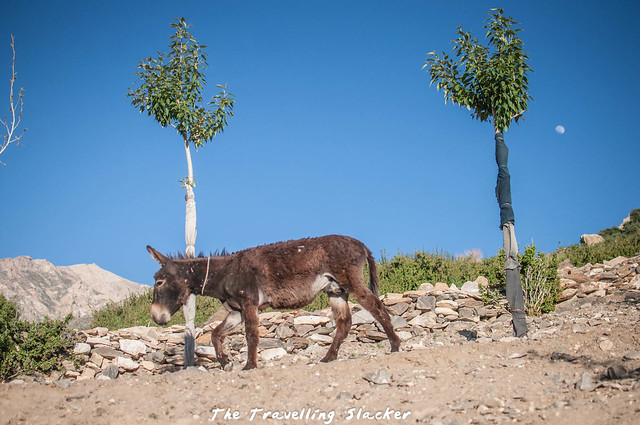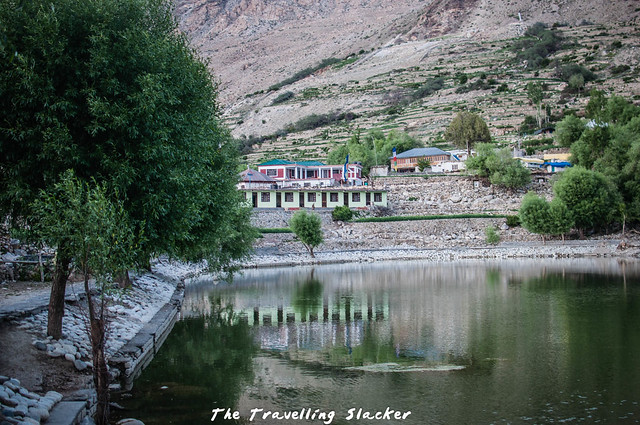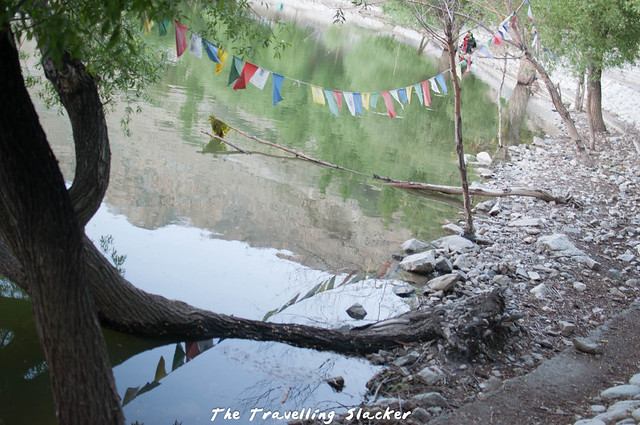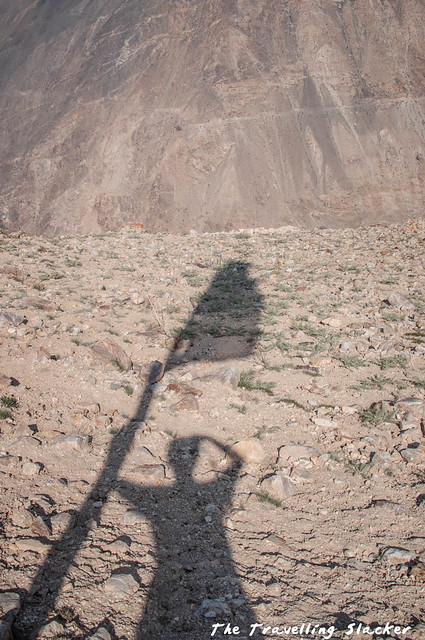It was 5 pm but the sun was truly blazing. I’d heard reports of heavy rains in Himachal but witnessed nothing but bright sunshine during my entire journey through Kinnaur. Now, at Nako, the cold desert of the rain shadow zone seemed to be truly living up to its name. Nako village is technically still a part of Kinnaur but the topographically it is as much a part of Spiti as it gets.
At 3600 metres, I expected to regret my decision of not carrying any warm clothing but I hardly felt the same as I walked under the sun. As expected, the moon was also visible at the same time on the other side of the clean, unpolluted sky.
Most of the hotels and homestays are situated at the entry point of the village. These are newly built concrete structures well equipped to host tourists. It was not exactly the peak season and so I had no problem in finding a room which was reasonably comfortable for INR 500. It was afternoon and my room was facing west. I came out shivering after the bath but then I stood still facing the sun for a while and felt a connection with it that I had never felt in the plains. The main village is a bit further away and the traditional architecture become visible once you enter the main village.
Village corners are expectedly filled with heaps of Mani stones and all the houses proudly hoist the prayer flags. I was expecting to see Yaks but was disappointed to see that even at this altitude people are rearing cows. I got lost a few times but finally I found the way to the lake. The lame seemed larger from the vicinity and as I took a round, I noticed only a couple of youth fishing patiently.
Having only a 35mm lens meant that I could never fit the lake in one frame. So, the best photograph of the lake seemed to be the one I took with my phone.
After the lake, I moved towards the famed monastery. However, I was completely mistaken regarding this. It is surely a historic structure but not a live one. It was founded by Lochen Rinchen Zangpo (Ratan Bhadra) in the 11th century. But it was destroyed in earthquake a century ago and was on its way to extinction. However, locals have now taken the responsibility and a village committee looks after it. Couple good looking buildings have been built in the complex but I am not sure what purpose they serve. There was not a single soul to be seen out there. After spending around 30 mins I saw exactly one villager who came, rolled the prayer wheels and went away. It was my fault as I hadn’t researched about it properly and was expecting a full fledged monastery full of monks.
The previous evening, I’d climbed the little hillock. In the morning I was tempted to climb the bigger hill beyond it. The peak looked remote and intimidating but my sense of adventure and prospective achievement was diluted immediately as I saw a local villager easily climbing the same with his animals, something as non-aerodynamically built as a cow.
I was sad anyways because I was expecting Yaks and just found too many cows in the village. Now even they overtook me to the top of the hill. Anyways, the same cowboy advised me to go further up, pointing at a distant flag. According to him another village will be visible from that point.
I listened to him and kept climbing. I found scores of prayer flags and Mani stones placed strategically to spread blessings all over the Hangrang Valley (The valley of which Nako is a part of). I have already described this part in the previous post. However, there was no sign of another village. I could just see more and more cloud covered peaks, deep valleys and serpentine roads in different directions. I trekked for almost two hours and finally reached another flag, probably installed as a milestone. I had to be back and catch the return bus so at this point I decided to give up my pursuit for the other village and started returning.
I noticed a few birds but most of them were too small to be captured. But I think due to the presence of a large water body within an arid region, this place is generally good for bidding. I just clicked one bird that looked like a sparrow, but slightly larger than what we normally see.
My Nako sojourn ended here. The return bus was on time. Bulk of the Spiti eludes me still. But I think it won’t be long before I correct that anomaly.





























Lovely images!
Thanks Niranjan
Thanks for the amazing images. I’d like to know more about how you reached this place. Usually it is the travel to remote places that is most difficult to plan, so any pointers in that matter would be great. Also, considering that the old monastery is almost completely gone, would you still suggest this place to other tourists? What else is there to explore here? I do see a valley in the backdrop of the lake image, is it visible from the village?
You have to take the bus… but you will find only one or two buses for the final stretch after Reckong Peo… so you have to be on time or waste the whole day…
Do not worry about the monastery… People visit this region mainly for the landscapes…
If you climb up the hills you will see a lot of valleys, gorges and also the Spiti River…
fabulous shots… seems like such a wonderful place… 🙂
cheers, Archana – http://www.drishti.co
Wonderful.
Nako is one of those remote places where time seems to have slowed down.
Lovely presentation.
Very good write up Jita! Moreover the photography is superb. I hope to visit the Himalayas once. Its a dream long overdue!
A 11th century monstery, the lovely round lake and sun and moon seen at the same time makes Nako sort of a magical place. Lovely shots there.
Wonderful shots.Really a magical place.
Cheers,
Sriram & Krithiga
Truly Awesome photos,
Jitaditya Thanks for your post.
Ah! It looks so out-of-the-world, J.
Thank you for showing me Nako. Gosh, it really is beautiful. 🙂
Thanks for sharing this article. Wonderful pics and such a lovely place it is . Best place for friends outing . have a look at these places in bangalore
fabulous photography…. Great pics… which camera you used.. any lens?